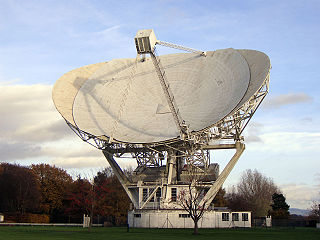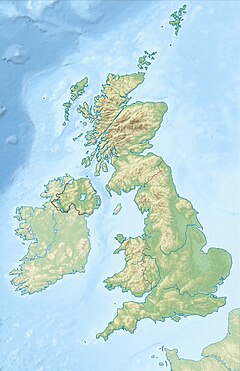Technical specifications
Funding for the telescope was obtained in 1963 from the DSIR. The telescope was designed by Husband and Co. consulting engineers, and was constructed by Fairey Engineering. It started observations in July 1967. The telescope could be controlled either locally, or by remote control over UHF and microwave links from Jodrell Bank Observatory (normally the latter). [3]
Similar to the Mark II, it had an elliptical dish with a major axis of 125 ft/38.1m and a minor axis of 83 ft 4 in/25.4m. [2] Unlike the Mark II, however, the dish is constructed of a wire mesh, with the wires 1-inch (25 mm) apart set to an accuracy of 0.5 inches (13 mm). When pointed to the horizon, the telescope was 81% efficient at wavelengths of 21 cm (the hydrogen line), dropping to 45% at 11 cm. When the bowl was pointed to the horizon, the structure deformed slightly under gravity, meaning that the telescope becomes 14% efficient at 11 cm. [3]
The focus cabin was an ~8 foot cube, also similar to the Mark II, supported by four steel girders. It could be accessed via a ladder up one of the girders, which could be climbed when the bowl of the telescope was directed towards the horizon. [3]
The telescope was steered in azimuth and elevation by hydraulic drive systems. Two of the six bogies on which the telescope sat were driven, and motion in elevation was done using two 16-foot (4.9 m) long hydraulic pistons. Both were driven by a 5 horse power electric motor, at up to 5 degrees per minute. The drive system was protected using over-pressure alarms, cut-outs and relief valves, as well as two alarms (one at the telescope, one at Jodrell). [3]
The main aim for the telescope when constructed was to use it in conjunction with the Lovell Telescope as a fully steerable interferometer to determine the sizes of radio sources. It was not known what size the radio sources would be, and so the optimal telescope separation was not known (the separation is inversely proportional to the resolution of the interferometer). As a result, the telescope was built such that it could be completely disassembled and reassembled on a new site within 6 months. [3]
The baseline between the telescope and the Lovell Telescope was 24 km, giving a resolution ranging between 0.2 and 17 arcseconds depending on the frequency that was being observed at. [3]
In 1996, [4] it was decommissioned due to its age and lack of sensitivity compared with modern telescopes. It was subsequently dismantled and sold for scrap.

A radio telescope is a specialized antenna and radio receiver used to receive radio waves from astronomical radio sources in the sky. Radio telescopes are the main observing instrument used in radio astronomy, which studies the radio frequency portion of the electromagnetic spectrum emitted by astronomical objects, just as optical telescopes are the main observing instrument used in traditional optical astronomy which studies the light wave portion of the spectrum coming from astronomical objects. Radio telescopes are typically large parabolic ("dish") antennas similar to those employed in tracking and communicating with satellites and space probes. They may be used singly or linked together electronically in an array. Unlike optical telescopes, radio telescopes can be used in the daytime as well as at night. Since astronomical radio sources such as planets, stars, nebulas and galaxies are very far away, the radio waves coming from them are extremely weak, so radio telescopes require very large antennas to collect enough radio energy to study them, and extremely sensitive receiving equipment. Radio observatories are preferentially located far from major centers of population to avoid electromagnetic interference (EMI) from radio, television, radar, motor vehicles, and other man-made electronic devices.

The Jodrell Bank Observatory hosts a number of radio telescopes, and is part of the Jodrell Bank Centre for Astrophysics at the University of Manchester. The observatory was established in 1945 by Bernard Lovell, a radio astronomer at the University of Manchester to investigate cosmic rays after his work on radar during the Second World War. It has since played an important role in the research of meteors, quasars, pulsars, masers and gravitational lenses, and was heavily involved with the tracking of space probes at the start of the Space Age. The managing director of the observatory is Professor Simon Garrington.

The Robert C. Byrd Green Bank Telescope (GBT) in Green Bank, West Virginia, US is the world's largest fully steerable radio telescope. The Green Bank site was part of the National Radio Astronomy Observatory (NRAO) until September 30, 2016. Since October 1, 2016, the telescope has been operated by the newly separated Green Bank Observatory. The telescope honors the name of the late Senator Robert C. Byrd who represented West Virginia and who pushed the funding of the telescope through Congress.

Sir Alfred Charles Bernard Lovell was an English physicist and radio astronomer. He was the first Director of Jodrell Bank Observatory, from 1945 to 1980.

The Multi-Element Radio Linked Interferometer Network (MERLIN) is an interferometer array of radio telescopes spread across England. The array is run from Jodrell Bank Observatory in Cheshire by the University of Manchester on behalf of Science and Technology Facilities Council (STFC) as a National Facility.
Aperture synthesis or synthesis imaging is a type of interferometry that mixes signals from a collection of telescopes to produce images having the same angular resolution as an instrument the size of the entire collection. At each separation and orientation, the lobe-pattern of the interferometer produces an output which is one component of the Fourier transform of the spatial distribution of the brightness of the observed object. The image of the source is produced from these measurements. Astronomical interferometers are commonly used for high-resolution optical, infrared, submillimetre and radio astronomy observations. For example, the Event Horizon Telescope project derived the first image of a black hole using aperture synthesis.

The Lovell Telescope is a radio telescope at Jodrell Bank Observatory, near Goostrey, Cheshire in the north-west of England. When construction was finished in 1957, the telescope was the largest steerable dish radio telescope in the world at 76.2 m (250 ft) in diameter; it is now the third-largest, after the Green Bank telescope in West Virginia, United States, and the Effelsberg telescope in Germany. It was originally known as the "250 ft telescope" or the Radio Telescope at Jodrell Bank, before becoming the Mark I telescope around 1961 when future telescopes were being discussed. It was renamed to the Lovell Telescope in 1987 after Sir Bernard Lovell, and became a Grade I listed building in 1988. The telescope forms part of the MERLIN and European VLBI Network arrays of radio telescopes.

The Effelsberg 100-m Radio Telescope is a radio telescope in the Ahr Hills in Bad Münstereifel, Germany. For 29 years the Effelsberg Radio Telescope was the largest fully steerable radio telescope on Earth. In 2000 it was surpassed by the Robert C. Byrd Green Bank Telescope in Green Bank, US which has a slightly larger elliptical 100 by 110-metre aperture.
The Cavendish Astrophysics Group is based at the Cavendish Laboratory at the University of Cambridge. The group operates all of the telescopes at the Mullard Radio Astronomy Observatory except for the 32m MERLIN telescope, which is operated by Jodrell Bank.
Sir Henry Charles Husband, often known as H. C. Husband, was a leading British civil and consulting engineer from Sheffield, England, who designed bridges and other major civil engineering works. He is particularly known for his work on the Jodrell Bank radio telescopes; the first of these was the largest fully steerable radio telescope in the world on its completion in 1957. Other projects he was involved in designing include the Goonhilly Satellite Earth Station's aerials, one of the earliest telecobalt radiotherapy units, Sri Lanka's tallest building, and the rebuilding of Robert Stephenson's Britannia Bridge after a fire. He won the Royal Society's Royal Medal and the Wilhelm Exner Medal.

The Mark II is a radio telescope located at Jodrell Bank Observatory, near Goostrey, Cheshire, in the north-west of England. It was built on the site of the 218 ft (66.4 m) Transit Telescope. Construction was completed in 1964. The telescope's design was used as the basis of the 60 ft (18 m) Goonhilly 1 telescope, and the Mark III telescope is also based on a similar design.
This is a Timeline of Jodrell Bank Observatory.

Defford is a small village in the county of Worcestershire, England, located between the towns of Pershore and Upton-upon-Severn. It was once part of the Royal forest of Horewell. The woodlands were mostly removed around the time of the Civil War.

The Alan Turing Building, named after the mathematician and founder of computer science Alan Turing, is a building at the University of Manchester, in Manchester, England. It houses the School of Mathematics, the Photon Science Institute and the Jodrell Bank Centre for Astrophysics. The building is located in the Chorlton-on-Medlock district of Manchester, on Upper Brook Street, and is adjacent to University Place and the Henry Royce Institute. While under construction the project was known as AMPPS : Astronomy, Mathematics, Physics and Photon Science. The building was shortlisted for the Greater Manchester Building of the Year 2008 prize, which is awarded by the Greater Manchester Chamber of Commerce. The manager of the building project was awarded a silver medal in the Chartered Institute of Building "Construction Manager of the Year" awards.

The Jodrell Bank Centre for Astrophysics at the University of Manchester, is among the largest astrophysics groups in the UK. It includes the Jodrell Bank Observatory, the MERLIN/VLBI National Facility, and the Jodrell Bank Visitor Centre. The Centre was formed after the merger of the Victoria University of Manchester and UMIST which brought two astronomy groups together. The Jodrell Bank site also hosts the headquarters of the SKA Observatory (SKAO) - the International Governmental Organisation (IGO) tasked with the delivery and operation of the Square Kilometre Array, created on the signing of the Rome Convention in 2019. The SKA will be the largest telescope in the world - construction is expected to start at the end of this decade.

Wardle is a village and civil parish in the unitary authority of Cheshire East and the ceremonial county of Cheshire, England. The village lies on the Shropshire Union Canal, north west of Barbridge Junction, and is 4 miles to the north west of Nantwich, and the parish also includes part of the small settlement of Wardle Bank. The total population is around 250. RAF Calveley was a flight-training station during the Second World War, and the Mark III radio telescope stood on the airfield site in 1966–96. The modern civil parish includes Wardle Industrial Estate and is otherwise largely agricultural. Nearby villages include Barbridge, Calveley and Haughton.

Pickmere is a village and civil parish near Knutsford in the Borough of Cheshire East. It has a population of 541. Landmarks in and around the village include a lake, Pick Mere, at grid reference SJ682770.
The International Pulsar Timing Array (IPTA) is a multi-institutional, multi-telescope collaboration, comprising the European Pulsar Timing Array (EPTA), the North American Nanohertz Observatory for Gravitational Waves (NANOGrav), and the Parkes Pulsar Timing Array (PPTA). The goal of the IPTA is to detect gravitational waves using an array of approximately 30 pulsars. This goal is shared by each of the participating institutions, but they have all recognized that their goal will be achieved more quickly in collaboration, and by combining their respective resources.

Ian Morison FRAS is an astronomer and astrophysicist who served as the 35th Gresham Professor of Astronomy.
Richard John Davis, OBE, FRAS was a radio astronomer for the Jodrell Bank Centre for Astrophysics at the University of Manchester.













